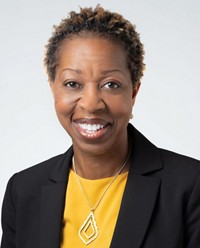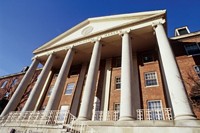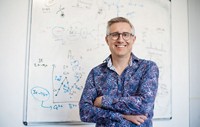Advertisement
Grab your lab coat. Let's get started
Welcome!
Welcome!
Create an account below to get 6 C&EN articles per month, receive newsletters and more - all free.
It seems this is your first time logging in online. Please enter the following information to continue.
As an ACS member you automatically get access to this site. All we need is few more details to create your reading experience.
Not you? Sign in with a different account.
Not you? Sign in with a different account.
ERROR 1
ERROR 1
ERROR 2
ERROR 2
ERROR 2
ERROR 2
ERROR 2
Password and Confirm password must match.
If you have an ACS member number, please enter it here so we can link this account to your membership. (optional)
ERROR 2
ACS values your privacy. By submitting your information, you are gaining access to C&EN and subscribing to our weekly newsletter. We use the information you provide to make your reading experience better, and we will never sell your data to third party members.
Diversity
Movers And Shakers
Science is full of personal stories. York’s David Smith thinks scientists should share them
Supramolecular chemist supports LGBTQ+ scientists by talking about his personal journey
by Katharine Sanderson, special to C&EN
April 24, 2018
| A version of this story appeared in
Volume 96, Issue 18

Chemists who attended the ACS national meeting in New Orleans last month hurried between the convention center and nearby hotels to listen to and share tales of their research endeavors. But not all researchers taking part in the meeting were there to talk about science alone.
Vitals
▸ Hometown: Manchester, England
▸ Education and experience: Ph.D., University of Oxford, 1997; postdoctoral researcher, Swiss Federal Institute of Technology (ETH), Zurich, 1997–99
▸ Favorite element: Nitrogen, which is responsible for so many of the coolest bits of biology and has been integral in compound design throughout Smith’s research career
▸ Favorite band: Marillion. This British rock group inspired Smith to join social media. The group had a competition to make a video for its 2008 song “Whatever Is Wrong with You.” “My gay-rights-themed video racked up tens of thousands of views and was chosen as the competition winner by the band’s singer,” Smith says. “I then set up a YouTube chemistry account (ProfessorDaveatYork), which has had over 500,000 views, shortly followed by my Twitter account (@professor_dave), which has around 10,000 followers.”
David K. Smith, a professor at the University of York who specializes in supramolecular chemistry, was invited to share details about his research but also to share his experiences as a gay man working to promote better diversity practices in the chemistry community and further afield. Smith told his story to attendees at an LGBTQ+ graduate student and postdoctoral scholar symposium and at a reception organized by the Royal Society of Chemistry. He spoke about how his husband Sam’s life-limiting condition, cystic fibrosis, inspired him to change his research direction and about his unflinching dedication to supporting diversity and outreach efforts.
Katharine Sanderson chatted with Smith afterward to learn more about his philosophy on bringing one’s whole self to the workplace.
How did you feel being invited to the ACS national meeting, not just because of your science but also because you are a member of the LGBTQ+ community?
I was slightly conflicted because as scientists, we all want to be recognized for our research. And as scientists we’re trained to believe that anything about us personally is not so important. But I’ve come to realize that it is important that we bring our whole selves to work. Being gay in science, female in science, an ethnic minority in science, or a parent in science—all of these things influence us as scientists. And we’re wrong to just pretend we can push that into the background.
What was it like before you came out as a gay chemist?
I started my research career in 1993, and I didn’t know any gay chemists at all. And I wasn’t out. It was a very different period in history than today: There was limited acceptance of gay people; the HIV crisis was still very apparent in the gay community. I’d got my full-time academic job at the University of York by the time I did come out in 2002. And that’s something I reflected on at the ACS conference. This was an event where LGBTQ+ scientists, young scientists in particular, were building a support network and friendships that might last them through their career. There was nothing like that in 1993.
I didn’t come out more widely until about 2005–2006. An undergraduate at York had complained to the head of the department that there was a lot of gossip about me as a member of academic staff and that it was very homophobic in nature. The undergrad, who was gay, said it was not a nice atmosphere. So I decided to talk more openly about who I am. Young gay people are known to have more mental health problems than straight people, and I just felt they needed to know there was somebody in the department who they could turn to. Nowadays, York’s chemistry department is quite rare in that we are focused on equality and diversity.
How has your research been influenced by your personal life?
Advertisement
Around the time I came out, my research began to change because I’d met the person who was going to become my husband, and he has the genetic disease cystic fibrosis. In 2005, my group started thinking about using genetic material (gene therapy) to treat cystic fibrosis. We started looking at DNA-binding systems to carry DNA across cell membranes and deliver the material in the body.
DNA’s quite a big charged molecule from a chemistry point of view. To bind it, we need quite a large system, with lots of points of interaction, that’s also multivalent. But lots of compounds that are big and multivalent tend to be toxic. So we self-assembled a large, multivalent system that could bind to DNA—but only temporarily. It’s designed to degrade into nontoxic bits. We’ve seen others use a very similar approach and go on to have more success than us, and they’re moving forward into clinical trials at the moment. That’s almost as satisfying as taking it through ourselves.
Has your relationship shaped your research in any other ways?
Sam had lung-transplant surgery in 2011. At that point, I talked to surgeons and anesthetists and learned that one of the key drugs in any surgery is heparin, which is used as an anticoagulant to prevent blood clots. At the end of surgery, you need to remove heparin from the patient with something called protamine sulfate that causes lots of problems for patients. I sat there at Sam’s bedside thinking, Well, heparin is just a big anion, like DNA is a big anion, and we have loads of stuff that binds DNA really well and works in the body, so in principle those compounds should be able to bind heparin. So we’ve been tailoring systems to improve the heparin rescue strategy after surgery.
Your personal life has been pivotal to your work life. How do you think telling people about your journey will help make chemistry more inclusive?
I like the opportunity to reflect a bit about life alongside science, and I think young scientists in particular find it very useful. I think many older scientists find it a bit threatening. There’s the attitude that all of it is irrelevant: “I don’t want to hear that you had kids. I don’t want to hear that you struggled with racial discrimination when you were in graduate school. I don’t want to hear that you’re gay and that coming out was difficult.” If you speak about any diversity issue—if you’re a woman talking about it, a gay person, a minority—the one thing that will get thrown against you is that you’re only talking about diversity issues because your science is no good. People say: “I want to hear about your science. All I’m going to judge you on is your scientific results.” And scientists would say that’s a really objective assessment of what people have achieved. If you can’t compete on their terms, then you’re not really worth considering.
It should be about quality. For example, one of our top professors at York has worked part time for the past 11 years. She’s only just gone full time, because she’s had young kids. She has won major national awards, she is one of the most highly regarded scientists in the U.K., and she’s achieved all that working 80% time.
I think Ph.D. students and postdocs in particular imagine you have to tread this cookie-cutter path to get to where you’re going. And I think a lot of people hiring academics think the same. Anything you can do to break down that view is very powerful.
Katharine Sanderson is a freelance science writer based in France. This interview was edited for length and clarity.
CORRECTION: This story was updated on April 25, 2018. The original story incorrectly stated that David Smith is a professor at York University. He is a professor at the University of York.





Join the conversation
Contact the reporter
Submit a Letter to the Editor for publication
Engage with us on Twitter